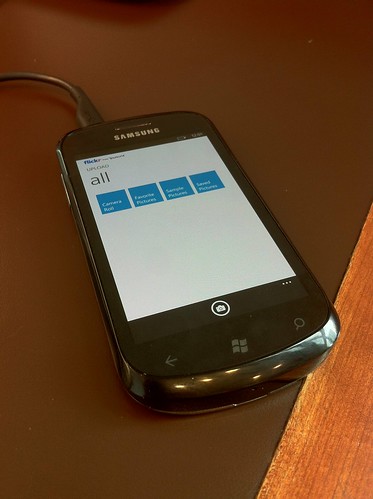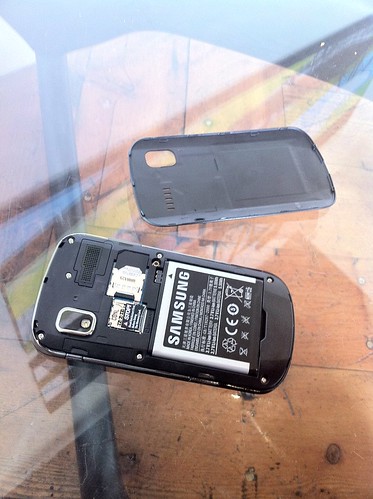Review: Samsung Focus with Windows Phone 7
Posted by Richard on Tuesday, 26 July 2011Over the course of four days, I installed the following apps through the Windows Phone Marketplace, listed here in alphabetical order: 1Password, Facebook, Flickr, Flux (Google Reader client), Foodspotting, Foursquare, Netflix, Public Transit (wrapper for Google Transit's website), Runkeeper, Shazam, Stacks for Instapaper, Twitter and YouTube. I resented having to install software to watch YouTube videos, and found the Flickr client incredibly slow. I was grateful that 1Password existed to access my 490 unique passwords, but was disappointed the app did not follow many Windows Mobile Phone 7 app conventions (tapping the hardware search button took me out of the app to Bing, for example). I was generally pleased with the other apps, especially the simplicity of the Twitter app and, compared with 3 years of iPhone experience, the completely different paradigms of Foursquare and Flux, to take only two examples.
I spent no money on apps, instead relying on either free or trial apps. Instapaper requires a $1/month subscription to its service in order to use 3rd party apps, so I bought the minimum 3-month subscription. I would have loved to try out the MLB At Bat™ app (since I'm a big fan and guaranteed buyer of the iPhone app; go on, Major League Baseball, keep raising the price, I'll happily keep paying), but a limited time with the phone didn't make a $11 purchase seem like a good idea. If I owned the phone, it would have been not only the first purchase but first app installed.
What I loved:
- The pane paradigm on the home screen and in apps, with a bit of the discoverable parts showing on the side. Text size is generally big in apps, meaning that going back to the iPhone, everything felt tiny. Tapping on icons made them looked pressed down, and sliding away after pressed is a nice visual touch.
- Trial mode apps. Theoretically iOS apps are trial mode with in-app purchase, but the WP7 marketplace made trial mode explicit.
- Apps like Foursquare and Twitter with their big, comfortable-on-the-eyes typefaces, and WP7-native design approach.
What I merely liked:
- Zune music player, though I wished album covers could be bigger, quicker access to the app from outside it. Swiping from side to side on an album cover switched back and forth between tracks, which doesn't make sense to this thirtysomething still used to pressing buttons to do the same.
- A hardware camera button, with pressing down slightly to focus. I expected to be able to take a picture in lock mode, or at least get to the camera by pressing the button. No such luck.
I liked the camera, but found it hard to get a non-blurry shot a little too often. For my comparison shot, I went to Caffe Rustico on Main St. and took a photo of their couch area with my iPhone 4 and from the same spot with the Samsung Focus. Not a huge difference to these eyes. The iPhone 4 had a wider shot and, with the HDR setting on, shows more in the window than the Samsung Focus.
What I neither liked nor disliked, but found weird:
- Every time I put the SIM card in, I had to reboot the phone. The iPhone spoiled me: put in a working SIM and you're good to go.
- The phone indicated, incorrectly, that I was roaming. In order to get access to the Internet over 3G, I had to turn on data roaming. Random forums of destiny told me that I can safely expect to not receive a roaming bill because of this.
- I stumbled on the FM radio receiver. Not a selling point, but if I were caught in a city-wide emergency which affected cell towers (say, an earthquake), I'd be grateful for it.
What I absolutely hated:
- Vibrating on the capacitive buttons. There is no ability to turns it off. Random forums of destiny confirmed this.
- A lot of mistaken taps on the capacitive buttons and mistaken hits on buttons, especially while in my pocket when only ever wanting to adjust the volume. Enlist me in the war against the capacitive button cult.
- Slow charging, when at all. The iPhone wall charger was better than through the computer, but I expected faster recharge times. I expected to be able to charge at least somewhat reliably through my MacBook Air.
- The default of the phone is to automatically save the screen and then lock, even while reading but not pressing any buttons. Maybe I could have turned it off, but I wanted to stick with the defaults as much as possible.
If I had more time with the device, I'd happily buy some apps, starting with MLB At Bat™, then Flux, then Stacks for Instapaper. I'd be very happy with the software and very unhappy with the hardware. Can I have an iPhone with Windows Phone 7 on it?





